
4. Safety instructions and warnings │ UK
13
Risk of injury from
rotating impeller.
Hair, clothing, jewellery etc. may
be pulled into the fan if you get
too close to it. During operation,
always keep far enough away to
prevent this from happening.
Health risk due to deposits on the
unit (mould, bacteria, dust etc.) after
the fan has not been used for a long time.
Clean unit at regular intervals, especially after
the fan has not been used for a long time.
A fan that is not mounted correctly
may result in non-intended operation
or impermissible operation. Ensure that
foreign bodies cannot be sucked into the unit
and ducts. With a free inlet, fit a protective
grille (e.g. SG protective grille). The unit may
be operated only if the protection against
accidental contact with the impeller is
guaranteed to be in accordance with
EN 13857.
Risk of injury and health risk in the
event of changes or modifications or
if components which are not permitted are
used. The unit may only be operated with
original components. Changes and
modifications are not permitted and release
the manufacturer from any guarantee
obligations and liability, e.g. if the housing is
drilled at a point which is not permitted.
Risk of injury/damage to unit if the
fan falls during installation/removal
(mounting/dismantling/cleaning/main
tenance) (weight 6.5 to 49 kg, depending
on type). During mounting work, ensure that
you are standing securely and cannot lose
your balance and that there is no one under
the unit. When removing and installing the
unit, support it from below with a hand.
Danger of injury when working at
heights. Use appropriate climbing aids
(ladders). Stability should be ensured, if
necessary have the ladders steadied by a
2nd person. Ensure that you are standing
securely and cannot lose your balance and
that there is no one under the unit.
High noise emissions near the fan.
Use additional visual warning signals to
secure the workplace area.
Risk of injury when handling housing
parts with sharp edges. Wear
protective gloves.
Risk during transport from heavy or
falling loads. Observe applicable
safety and accident prevention requirements.
Do not stand under a suspended load. Check
unit for transport damage.
Danger of electric shock when
operating a fan which is damaged or
not fully mounted. Before working on
the fan, shut down all supply circuits (switch
off mains fuse), secure against being
accidentally switched back on and position a
visible warning sign. Only operate the fan
when it is completely installed. Do not
commission a damaged unit. Prevent the unit
from being switched back on until it has been
fully repaired.
Hearing damage caused by spending
prolonged periods directly next to
the unit while it is running. Depending on
type, sound power levels L
WA5
of up to
91 dB(A). When planning, take into account
sound insulation at the installation site when
planning. If necessary, use hearing
protection.
Risk of injury in case of incorrect
mounting, if the fan falls down due to
its inherent weight. The fan vibrates slightly.
Mounting only on walls/ceilings/brackets with
sufficient load-bearing capacity and with
sufficiently dimensioned mounting material.










